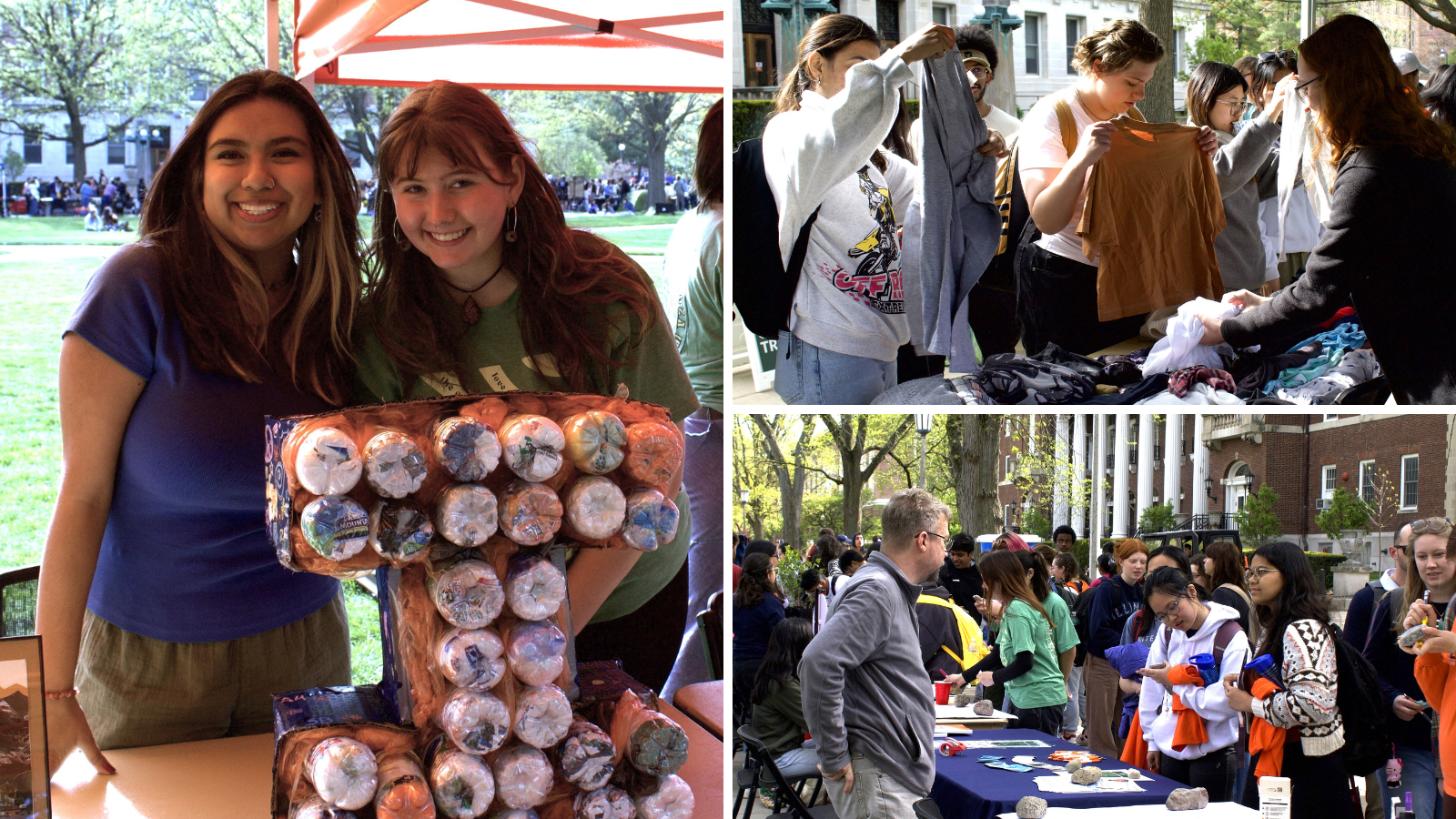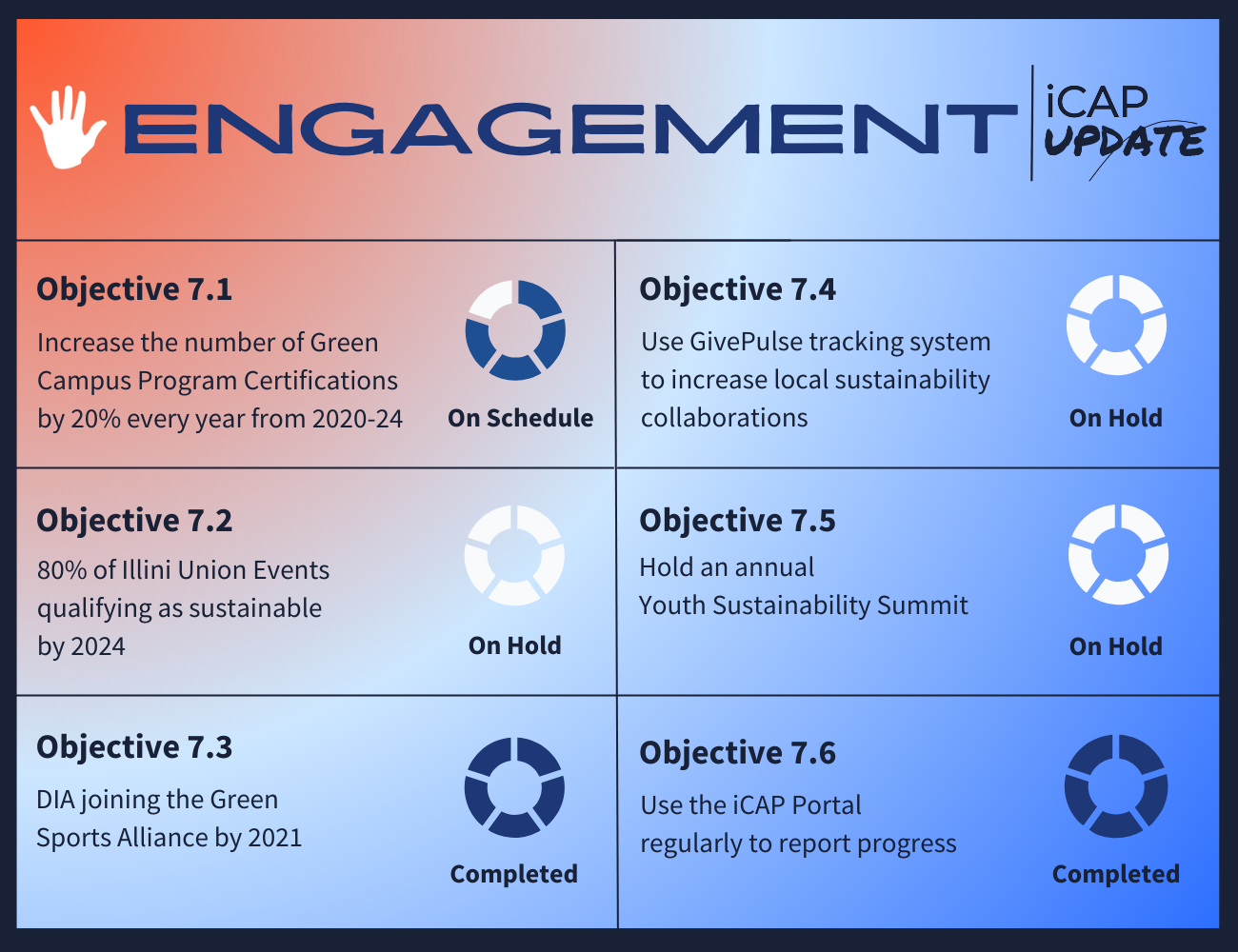
The University of Illinois Urbana-Champaign is well past the halfway point from Illinois Climate Action Plan 2020 to iCAP 2025. It’s time to check in on each of the iCAP chapters to gauge progress, address the challenges our campus faces, and celebrate some achievements. This month, iSEE Communications Intern Gabe Lareau examines the Engagement chapter to see what the university is doing to immerse campus in a culture of sustainability. He also recaps the progress and challenges as we begin the drafting process for iCAP 2025 — which will mark 25 years (or hopefully less) until campus reaches carbon neutrality. View the full series >>>

More than 4,000 students took part in the Spring 2024 “Sustainapalooza” organized by the Student Sustainability Leadership Council and co-hosted by iSEE, the Student Sustainability Committee, Students for Environmental Concerns, and the Illini Union Board. The event featured tabling by sustainability organizations, iSEE’s free clothing swap, a sustainable art show, food, and music. Credits: Diana Gonzaga/iSEE Communications
They may seem like basic questions:
- Do you know how composting works?
- Are you up to date on what can be recycled, and what can’t?
- What do you know about the Illinois Climate Action Plan?
But for taking the pulse of sustainability literacy at the University of Illinois, these questions are vital to see how knowledgeable, up to snuff, and aware the campus actually is. Or, in another word, engaged.
For Codie Sterner, the word is literally in the job description. Appointed last year as Student Affairs’ Coordinator for Student Sustainability and the Engagement iCAP Team Chair, he knew that crafting a sustainability survey for university staff was of “exponential importance” early on. The Education Team is preparing a similar survey for incoming students.
According to Sterner, there’s a knowledge gap on campus: “There’s been a ton of interest with sustainability literacy. We’ve been getting questions like, ‘Hey, we would love to know what to do to make this a green event, but we actually don’t know what to do.’ ”
The sustainability literacy survey for university staff, due to be released soon, is just one of the main successes in the engagement realm. Others — successfully working with the Department of Intercollegiate Athletics (DIA) to join the Green Sports Alliance, increasing the number of Green Events certifications, and making regular updates to the iCAP Portal website — have been paramount to fulfilling the team’s iCAP 2020 objectives.
But, as with every other iCAP chapter’s objectives list, challenges still lie ahead. Most for the Engagement Team revolve around one fact: With a university as large and diverse as Illinois, the team is still trying to tailor messaging to as much of campus as possible.
Part of that process has been a heavier focus on some objectives over others and, in some cases, a complete restructuring. Take for example Objectives 7.4 and 7.5, respectively: using GivePulse — a volunteer, engagement, and fundraising service — to bolster campus-community collaboration on sustainability issues; and holding an annual Youth Sustainability Summit as part of a broader effort to teach children environmental stewardship.
For Sterner and the rest of the team members — all of whom have participated for only a year — evaluating if these objectives are the best ways to engage campus is a valid question.
“We dug into some of these objectives,” Sterner said. “Maybe some of them don’t necessarily need to be replaced, but they might not be as applicable today as they were originally. We’ve had to ask, ‘How do you reframe the question? How do we modernize it?’ A lot of stuff has changed since 2020.”

The iCAP Engagement Team has worked with the Illini Union, Athletics, and other iCAP teams on sustainability initiatives — and campaigned to find volunteers for myriad events. However, its main challenge is defining what its role should be as campus pushes to net zero.
No argument there. But what to do in the meantime? The answer: Be as multi-purpose as a Swiss Army knife.
The Engagement Team has become the Illinois Climate Action Plan’s all-in-one resource. It is the iCAP’s central connectivity hub, Army Reserves, and PR team: If any of the iCAP teams need boots on the ground fast, the Engagement Team is ready to deploy.
Nowhere was this more apparent than during the university’s most recent Zero Waste events. “We had people asking where they could get volunteers,” Sterner said. “So one of our students on our team worked with the Office of Civic Life, and we were able to generate a lot of volunteers for these programs for the Zero Waste Team.”
Other ongoing sustainability programs, like Green Quad Day and “Sustainapalooza”— an event newly conceived by the Student Sustainability Leadership Council (SSLC) — were identified by the Engagement Team as opportunities to collaborate with other campus sustainability organizations in mobilizing students to get them involved in campus sustainability projects.
Or, put more succinctly by Sterner, “Get a group that’s passionate enough, realign everyone’s goals, and move forward rapidly.”
Sounds a lot like engagement.
Wrapping up our iCAP retrospective …
So, where do we go from here? Based on our roundup of progress and challenges since iCAP 2020, the University of Illinois community must keep three main things in mind if it truly wants to achieve net-zero greenhouse gas emissions no later than 2050:
Energy, Energy, Energy
How each iCAP chapter directly impacts the university’s greenhouse gas emissions varies significantly. The vast majority of our carbon emissions come from how campus makes its energy, which is mostly through the fossil fuel-powered Abbott Power Plant.
Campus has pursued almost every option for renewable energy available — solar, wind, geothermal, nuclear — but all of those and more will be required to cut university emissions to zero.
The U of I has made progress on that front. In 2008, the university emitted 575,088 tons of greenhouse gases. In 2023, that dropped to 391,279 tons, within reach of the 2025 goal of 344,906 tons.
Individual actions, like turning off lights, unplugging electronics, using more efficient appliances, and taking shorter showers, can aid in reducing that figure only en masse. And still they will not be enough to get campus emissions to zero. Therefore, campus must continually emphasize updating its energy infrastructure as the priority.
It’s all interconnected
We’ve had a drought the past two years here in Champaign-Urbana, which has killed a significant number of trees that were planted on campus to help us reach our Land & Water goals. The lack of trees, in turn, makes our community less resilient to increased stormwater surge.
Just one example of how the problems that each iCAP chapter tackles are so intertwined. That idea applies to solutions as well.
Perhaps the most effective way to reduce university emissions isn’t by re-engineering solar panels to be a fraction of a percent more efficient. Instead, it could be through advocacy. Maybe the best way to get people to reduce driving time is by making walkways and bike paths more shaded and, therefore, more enjoyable. Or perhaps students in the university’s Environmental Leadership Program (a successfully completed objective in the Education chapter) could even lobby lawmakers to ban state institutions from using, or investing in, fossil fuels.
Thinking of the climate issue on our campus or anywhere through the lens of one single discipline, cause, or iCAP chapter only narrows our solutions. Seeing our individual work as something that can have vast repercussions — whether good or ill — can make us more aware and deliberate in our decisions as the university continues toward net zero.
Let the students lead
Finally, campus must never forget its greatest asset and very reason for existence: Its students. Our generation and those of the future will live with climate change’s worst effects — things that we were not necessarily responsible for creating.
As an individual of this campus and a resident of this planet, by far the most impactful thing you can do is get yourself, as well as others, involved. At a university with over 50,000 people, changing the energy infrastructure, cutting down on food and plastic waste, reducing energy and water demand, and advocating for land management practices that increase carbon storage can only be accomplished together.
“Since the iCAP 2020, we’ve made major progress to decrease our carbon footprint and improve environmental sustainability on campus. This is the result of cross-campus efforts led by Facilities & Services, the iCAP teams, iSEE, and other partners in sustainability efforts like the Illini Union, DIA, the Office of Student Success, Inclusion and Belonging, and many others – notably the Student Sustainability Committee and student groups that help mobilize support for sustainability initiatives,” said iSEE Sustainability Programs Coordinator Miriam Keep.
“There is still much work ahead of us, and we look forward to continuing to work across campus and build new partnerships to meet our long-term sustainability goals with the iCAP 2025!”
There is a place for everyone here, not just the scientists or the engineers or the communications experts. Skilled and willed people from every discipline and every background are needed to get our campus to net zero.
And by banding our voices together, we might advocate for the necessary change at a larger level: asking the Urbana-Champaign campus, the University of Illinois system, and the state that governs it to align their wallet with their words.
For centuries, we Illini have gone on to do great things in the world. That process does not have to start after we walk across the graduation stage. If we can truly change our complex, large university into a bastion of climate action, more organizations — other universities, corporations, governments — will see proof that sustainability is truly possible, and then, hopefully, follow in our footsteps.